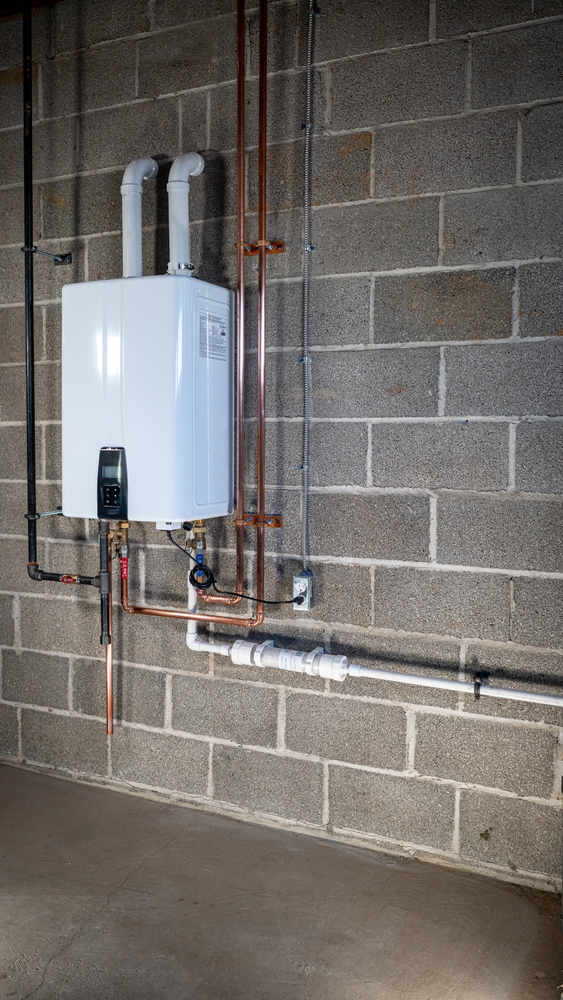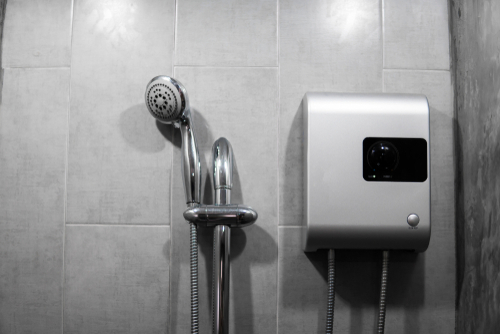August 30, 2023
Tankless Water Heater Basics
Your Guide to Tankless Water Heater Pros and Cons
If you’re remodeling your home or thinking about replacing a hot water heater, you might be considering tankless or instant water heating. Unlike traditional water heaters that heat up water and store it in a large tank, tankless water heaters heat up water on demand, only producing as much as is needed for immediate use.
There are many good reasons to consider either a whole-house tankless water heating system or several strategically placed “booster” tankless hot water heating units. To help you with your decision, here are some of the basic facts about tankless water heaters.
How Does a Tankless Water Heater Work?
Tankless water heaters produce hot water on demand via a heating element that instantly heats the water as it passes across the element on its way to the tap. Because you’re not storing water in a tank and constantly using energy to keep it at a standard temperature, you can save a significant amount on your utility bills
There are two main types of tankless water heating units: electric powered and gas-fired. Gas-fired units are able to generate a higher flow than electric units.
The Benefits of a Tankless Water Heater


Let’s start with the reasons you might install a tankless water heater (or two) in your home.
Space Savings
While a traditional tank-based water heater system has a large tank that can take up an entire utility closet, a tankless water heater is about the size of a suitcase. It attaches neatly to the wall or next to the wall, potentially opening a significant amount of extra storage space, especially in new constructions where you can install a tankless water heater under a bathroom sink or next to an outdoor shower.
Lower Energy Costs
Tankless water heaters streamline energy usage in your home. While a traditional system will run more often to fill up the tank almost every time you use hot water, a tankless system only uses as much energy as it needs to produce hot water on demand for exactly as long as needed. This could save you 8-35% on your utility bill costs depending on how much water your home uses.
No Running Out of Hot Water
With a traditional water heater, if the tank runs out, you have no more hot water until it refills. Depending on how old and how large the system is, this could potentially take hours. Tankless systems completely avoid this problem and provide as much hot water as you need whenever you need it.
Perfect for Vacation and Second Homes
When you are not staying in a second home or a vacation home, it is always wise to turn off any appliances and utilities not in use. This saves money and protects your property. Using tankless water heaters in these second homes eliminates the risk of a leaking water heater tank and the cost of leaving the water heater running when you’re not there. It also saves you the long wait as gallons and gallons of water in the tank to heat up when you do use the house.
Deliver Hot Water to The Second Floor Faster
Consider the amount of water used when you run water waiting for the hot water to reach the tap you are using. If there is only a short distance between the water heater and the tap, you might not waste a lot of water. But if the water must travel to the other end of the house, you could waste a large amount of water and you might find that the water cools somewhat as it passes through the pipes. A tankless water heater provides instant hot water at the desired temperature.
Longevity
Storage water heaters usually last 8 to 15 years; tankless units last 20 years or more. With proper maintenance, your tankless heater can prove to be a smart long-term investment.
No Leaks
Tankless water heaters do not cause leaks and flooding due to cracking of the storage tank or a leak in a key pipe because no water is being stored.
Disadvantages of Tankless Water Heater Systems
While there are plenty of reasons to install a tankless water heater in your home, there are some disadvantages too. Here are a few to consider.
Difficulty Maintaining Supply


Tankless water heaters are improving but they typically perform best in smaller efficiency homes. If you have a large floorplan with many different water-dependent appliances, a tankless system may not provide the level of performance you expect or you may need to install multiple units throughout your home.
The “Cold Water Sandwich Effect”
If your tankless water heater struggles to keep the supply up, you may experience the “cold water sandwich effect.” This occurs when hot water stops for a few seconds while your heater catches up. You might experience sudden and unexpected bursts of cold water.
Upfront Cost
Tankless water heater Installation can be more expensive for some homes, typically requiring pipe replacements and additional installation work. However, they have very low long-term repair and maintenance costs, and replaceable parts for tankless systems are quite affordable. Over time, the savings can easily pay for the slightly high initial cost of installation.
Not Compatible with Hard Water
Hard water can quickly gum a tankless water heater with mineral scale. If you live in an area that has hard water, you’ll want to use a water softener to keep it running efficiently. You’ll also want to descale your tankless water heater often.
No Electricity, No Hot Water
Tankless heaters, even gas models, require electricity to work. During a power outage, you’ll be without hot water.
Maintenance
As with a traditional water heater, perform tankless water heater maintenance annually. This involves cleaning out sediment or scale that may have built up within and replacing and failing parts. Have a licensed plumber perform your maintenance to ensure it’s done properly and that no important issues are overlooked.
Is a Tankless Water Right for Your Home?
If you’re weighing the pros and cons of a tankless water heater, contact Applewood today for more information about your options. We can discuss the models that would be appropriate for your budget and water consumption so that you can make an informed decision.


